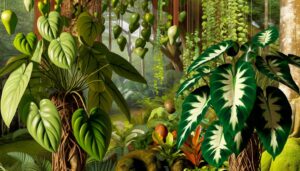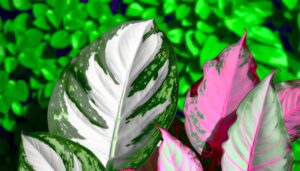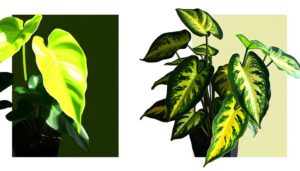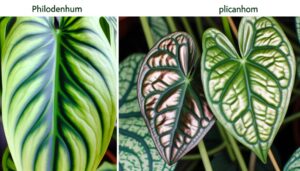Philodendron Andreanum Vs Melanochrysum: Key Differences!
Philodendron andreanum and Philodendron melanochrysum are two distinct species endemic to different ecological niches. Andreanum, from Colombian and Ecuadorian rainforests, has glossy heart-shaped leaves, favoring compact growth with high humidity.
Conversely, melanochrysum hails from the cooler high-altitude cloud forests of the Colombian Andes, featuring elongated, velvety leaves and strong climbing habits. Andreanum prefers consistently moist soil, while melanochrysum benefits from occasional drying.
Both require bright, indirect light and similar temperature and humidity levels. Each species has evolved specific adaptations to their environments, offering unique challenges and rewards for enthusiasts seeking deeper insights into their care and growth.
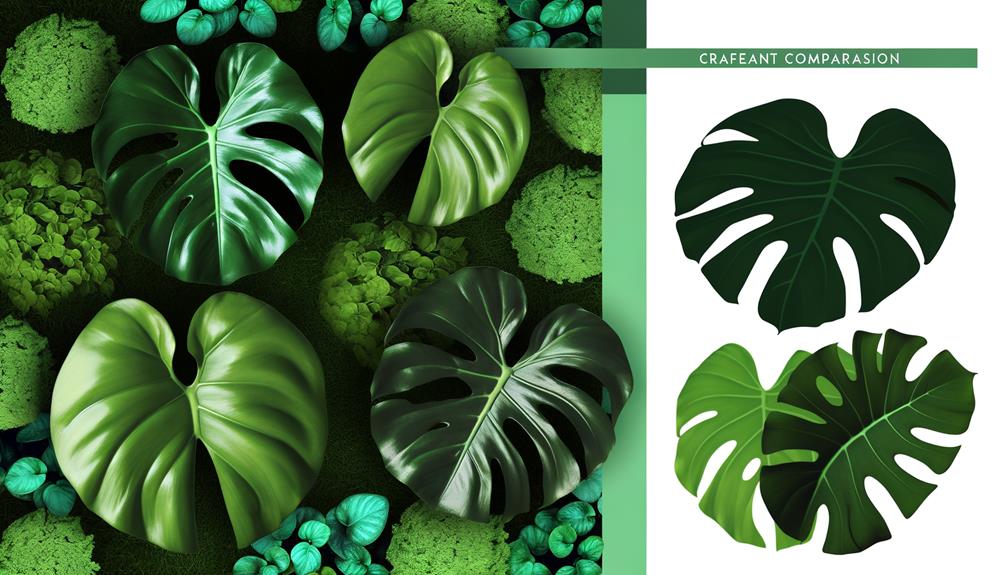
Comparison of Philodendron Andreanum and Philodendron Melanochrysum
| Characteristic | Philodendron Andreanum | Philodendron Melanochrysum |
|---|---|---|
| Scientific Status | Synonym | Accepted scientific name |
| Origin | Colombia | Colombian Andean foothills |
| Leaf Color | Dark, almost black | Blackish-green with golden sparkles |
| Leaf Shape | Heart-shaped, cordiform-lanceolate | Heart-shaped |
| Leaf Size | Up to 4-5 feet long | Typically 25 cm, can grow longer |
| Growth Habit | Climbing | Climbing |
| Leaf Texture | Velvety | Velvety |
| Young Leaf Color | Scarlet tinge, bronzy red-brown | Copper-gold sheen |
| Mature Leaf Color | Bright velvety green | Blackish-green with pale green veins |
| Discovery | Discovered by M. Andre | First cultivated in Europe since 1886 |
| Cultivation History | Exhibited in 1886 by Veitch Nurseries | Widely cultivated as an ornamental |
Origins and Natural Habitat
Philodendron andreanum originates from the tropical rainforests of Colombia and Ecuador, where it thrives under high humidity and filtered light. P. andreanum’s habitat is characterized by a consistent warm climate and substantial moisture levels, facilitating its growth in the dense understory.
Philodendron melanochrysum is native to the cloud forests of the Colombian Andes, flourishing in cooler temperatures and high-altitude environments. P. melanochrysum adapts to the cooler, mist-laden conditions of the Andean cloud forests, which provide a unique microclimate with high humidity and diffused sunlight.
Understanding these distinct ecological niches is essential for cultivating these species in non-native environments. Their specific temperature and moisture requirements must be meticulously replicated for best growth and health.
Leaf Shape and Texture
The leaves of Philodendron andreanum are typically heart-shaped with a glossy, smooth texture, while those of Philodendron melanochrysum exhibit an elongated, velvety surface, each reflecting their adaptation to their respective native habitats.
Philodendron andreanum’s glossy leaves facilitate efficient water run-off in its humid environment, minimizing fungal growth. In contrast, the velvety texture of Philodendron melanochrysum leaves, covered in fine trichomes, aids in capturing moisture from the air, a beneficial adaptation for its epiphytic lifestyle.
The heart-shaped leaves of andreanum maximize light capture, essential for photosynthesis under the forest canopy. Conversely, the elongated leaves of melanochrysum enhance surface area for gas exchange, optimizing its metabolic processes. These morphological differences underscore their evolutionary adaptations.
Growth Patterns
In examining the growth patterns of these two Philodendron species, one observes distinct differences in their vining and climbing behaviors, reflective of their ecological niches and adaptive strategies.
Philodendron andreanum tends to exhibit a more compact growth habit, favoring a self-branching structure that results in a bushier appearance.
Conversely, Philodendron melanochrysum demonstrates a pronounced climbing tendency, utilizing aerial roots to ascend vertical supports.
- Philodendron andreanum: Compact, self-branching, bushy growth
- Philodendron melanochrysum: Strong climber, extensive use of aerial roots
- Adaptive Strategies: Reflective of their natural habitats
These distinctions underscore how each species has evolved to optimize its growth for specific environmental conditions, thereby influencing their overall morphology and cultivation requirements.
Light Requirements
Philodendron Andreanum and Philodendron Melanochrysum exhibit distinct light requirements that greatly impact their growth and overall health.
Ideal light conditions for these species vary, with differences in their tolerance to shade and response to direct sunlight.
Analyzing these factors is vital for optimizing their cultivation in both natural and controlled environments.
Ideal Light Conditions
For best growth, Philodendron andreanum and Melanochrysum require bright, indirect sunlight to mimic their natural understory rainforest environments.
This light condition ensures peak photosynthesis without the risk of leaf burn, which can occur under direct sunlight. Analyzing the light spectrum, these plants thrive under conditions where light is diffused and evenly distributed.
- Intensity: Aim for light levels around 10,000 to 20,000 lumens.
- Duration: Maintain 12 to 14 hours of light daily, simulating tropical day lengths.
- Source: Utilize sheer curtains, grow lights, or shaded areas to achieve the desired lighting.
These parameters are essential to fostering vigorous growth and maintaining the lush, vibrant foliage characteristic of both species.
Tolerance to Shade
Shade tolerance in both Philodendron andreanum and Melanochrysum is an important aspect of their adaptability, as these species can endure lower light conditions owing to their evolutionary origins beneath dense rainforest canopies. This characteristic enables them to thrive in indoor environments with indirect lighting.
Philodendron andreanum exhibits strong shade tolerance, maintaining healthy foliage with limited light exposure. Similarly, Philodendron melanochrysum, with its velvety leaves, shows a high degree of adaptability to shaded conditions. Both species, however, do exhibit some differences in their best shading preferences.
While P. andreanum can tolerate slightly lower light levels, P. melanochrysum benefits from moderately brighter indirect light to sustain its vibrant coloration and growth. Understanding these distinctions is important for optimal plant care.
Growth With Direct Sun
Direct sunlight can have varying impacts on the growth and health of Philodendron andreanum and Melanochrysum, with potential implications for leaf integrity and overall plant health. Philodendron andreanum, with its robust foliage, exhibits moderate tolerance to indirect bright light but suffers under direct sunlight, leading to leaf scorch and chlorosis.
Conversely, Melanochrysum’s delicate, velvety leaves are highly susceptible to direct sun exposure, resulting in rapid desiccation and necrosis.
Key considerations include:
- Leaf Damage: Direct sunlight can cause sunburn, leading to unsightly brown or yellow patches.
- Hydration Needs: Increased sunlight accelerates water loss, necessitating more frequent watering.
- Photosynthetic Efficiency: Both species achieve optimal photosynthesis under filtered sunlight, enhancing growth without risking leaf damage.
Properly managing light exposure is essential for these philodendrons.
Watering Needs
Understanding the watering needs of Philodendron Andreanum and Melanochrysum is essential for their best growth and health.
Both species exhibit distinct preferences for soil moisture levels and ideal watering frequency, with the former favoring consistently moist soil and the latter requiring occasional drying out between waterings.
An analysis of these factors will clarify the specific care requirements necessary to maintain vigorous and thriving plants.
Optimal Watering Frequency
Determining the best watering frequency for Philodendron andreanum and Melanochrysum requires a detailed understanding of their specific hydration needs, environmental conditions, and soil moisture retention capabilities. Both species thrive under conditions that prevent waterlogging yet ensure consistent moisture.
Analytical observations indicate several factors influencing optimal watering schedules:
- Environmental Humidity: High humidity levels reduce the frequency of watering needed.
- Light Intensity: Increased light exposure accelerates water evaporation from the soil, necessitating more frequent watering.
- Plant Size and Root Mass: Larger plants with extensive root systems require more water compared to smaller specimens.
Soil Moisture Preferences
Given the factors influencing best watering schedules, it is crucial to understand the soil moisture preferences of Philodendron andreanum and Melanochrysum to maintain their health and growth.
Philodendron andreanum thrives in consistently moist but not waterlogged soil. It benefits from well-draining substrates rich in organic matter, ensuring that moisture is retained without risking root rot.
Conversely, Philodendron melanochrysum prefers a slightly less moist environment. It requires the soil to dry out partially between waterings, necessitating a mix that promotes aeration and drainage.
Both species benefit from a balanced approach where overwatering and underwatering are carefully avoided. Employing moisture meters and monitoring soil conditions can greatly enhance their growth, ensuring the best hydration levels tailored to their specific needs.
Soil Preferences
Philodendron andreanum and Melanochrysum exhibit distinct soil preferences that are crucial for their finest growth and overall health. Philodendron andreanum thrives in a well-draining, airy soil mix that retains some moisture but prevents waterlogging. A combination containing peat, perlite, and orchid bark is ideal.
In contrast, Melanochrysum requires a more moisture-retentive yet well-aerated substrate to support its delicate roots. Key components for their respective soil mixes include:
Philodendron andreanum prefers:
- Peat for moisture retention
- Perlite for enhanced drainage and aeration
- Orchid bark for structure and breathability
Melanochrysum benefits from:
- Higher organic content for moisture retention
- A mix that includes coco coir
- Improved aeration via perlite or pumice
These tailored soil preferences ensure prime nutrient uptake and root health.
Temperature and Humidity
Maintaining ideal temperature and humidity conditions is crucial for the thriving growth of Philodendron andreanum and Melanochrysum, complementing their specific soil needs.
Both species flourish in temperatures ranging from 65°F to 80°F (18°C to 27°C), with a noted intolerance for temperatures below 55°F (13°C).
Relative humidity levels should be maintained between 60% and 80% to replicate their native tropical environments. Inadequate humidity can lead to leaf desiccation and reduced growth rates. Utilizing humidity trays, misting, or a humidifier can improve dry indoor conditions.
Temperature fluctuations, particularly drafts or cold air, should be minimized to prevent stress. Accurate monitoring with thermometers and hygrometers guarantees these parameters remain within optimal ranges, fostering robust and healthy plant development.
Pruning and Maintenance
Effective pruning and maintenance are essential for promoting the robust growth and aesthetic appeal of both Philodendron andreanum and Melanochrysum. Regular pruning promotes strong foliage development and mitigates the risk of disease by improving air circulation. It is recommended to use sterilized tools to prevent pathogen transmission.
Key maintenance practices include:
- Selective Pruning: Remove dead or yellowing leaves to preserve plant energy.
- Node Trimming: Cut just above a node to stimulate new growth and bushier plants.
- Periodic Inspection: Regularly check for signs of stress or environmental imbalance.
These practices not only enhance the plant’s health but also contribute to its ornamental value, making them essential for any dedicated philodendron enthusiast. Proper maintenance guarantees these plants reach their full potential in both form and function.
Common Pests and Diseases
Both Philodendron andreanum and Melanochrysum are prone to a variety of common pests and diseases that can compromise their health and aesthetic appeal. Noticeably, spider mites, aphids, and mealybugs frequently infest these species, feeding on the plant sap and causing foliage discoloration and wilting.
Fungal infections such as root rot and leaf spot are widespread due to excessive moisture and poor air circulation. Bacterial blight, characterized by water-soaked lesions, can rapidly spread, exacerbating plant stress.
Preventative measures include maintaining ideal humidity, ensuring proper drainage, and regular inspection. Integrated Pest Management (IPM) strategies, encompassing mechanical removal, biological controls, and targeted use of insecticides, are recommended for effective management.
Vigilance and timely intervention are vital to maintaining plant health.
Conclusion
In the intricate dance of botanical splendor, Philodendron andreanum and Melanochrysum exhibit distinct characteristics shaped by their unique origins and environments. Their divergent leaf morphologies, growth habits, and care requirements delineate a vivid portrait of nature’s adaptability.
The interplay of light, water, and soil reveals each species’ nuanced needs, while temperature and humidity preferences underscore their ecological niches. Pruning, pest control, and disease management further highlight the intricate ballet of maintaining these verdant treasures, encapsulating the complexity of botanical stewardship.

